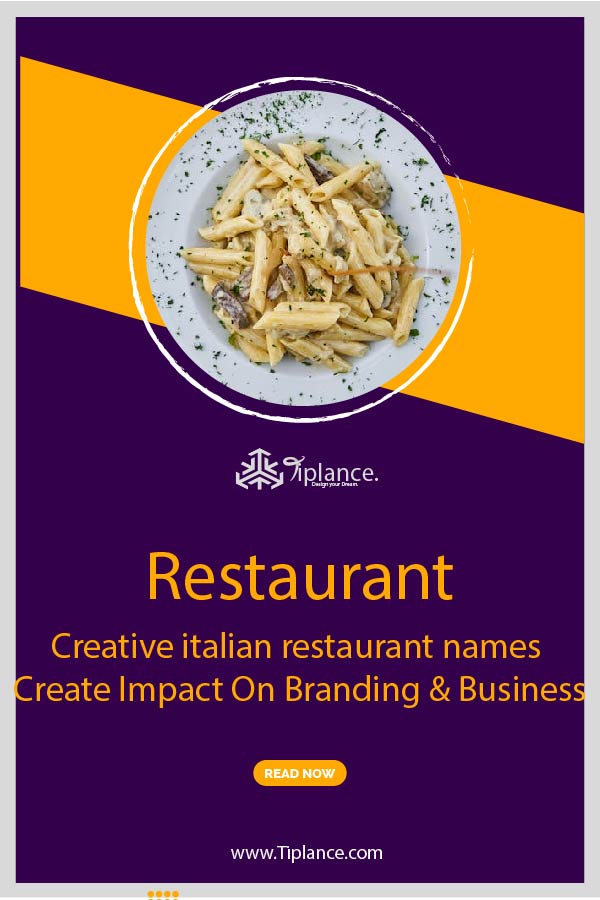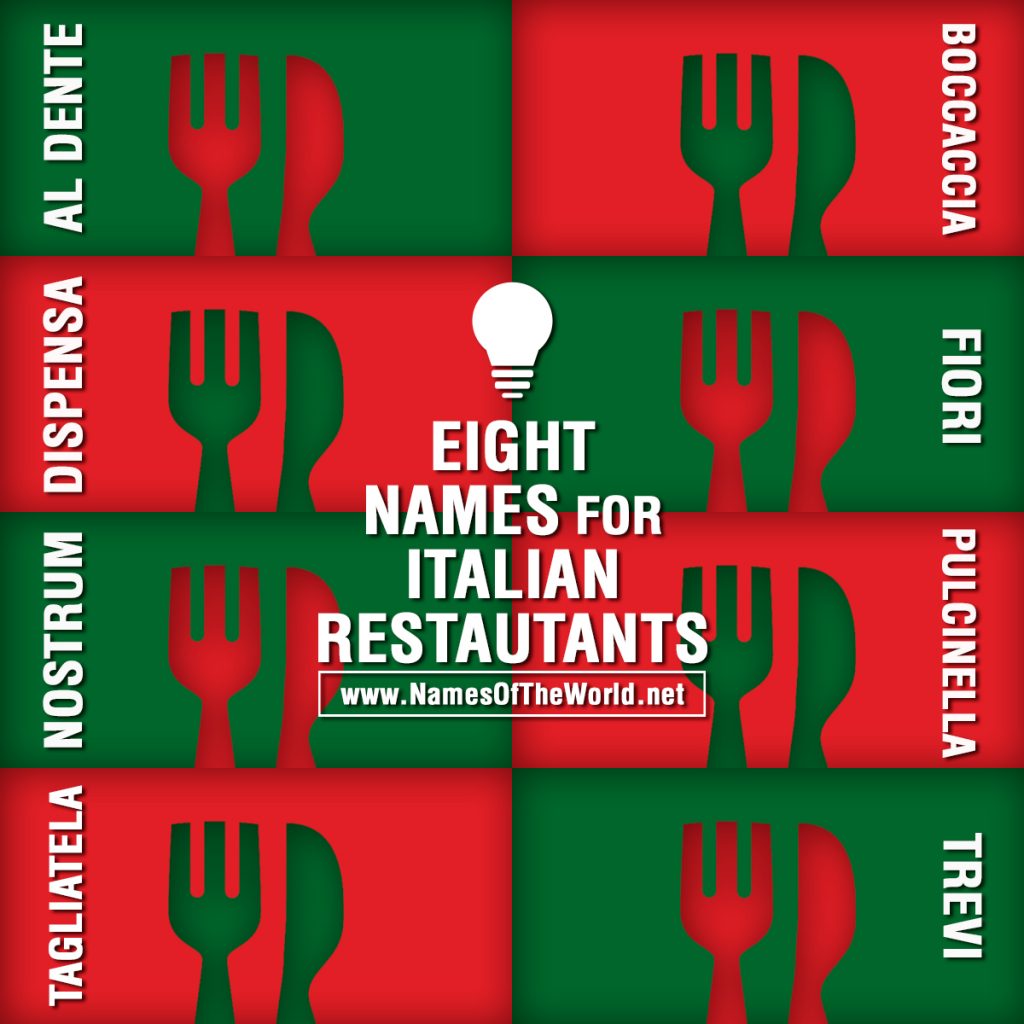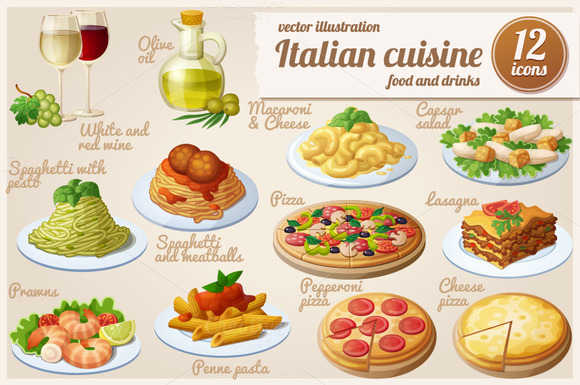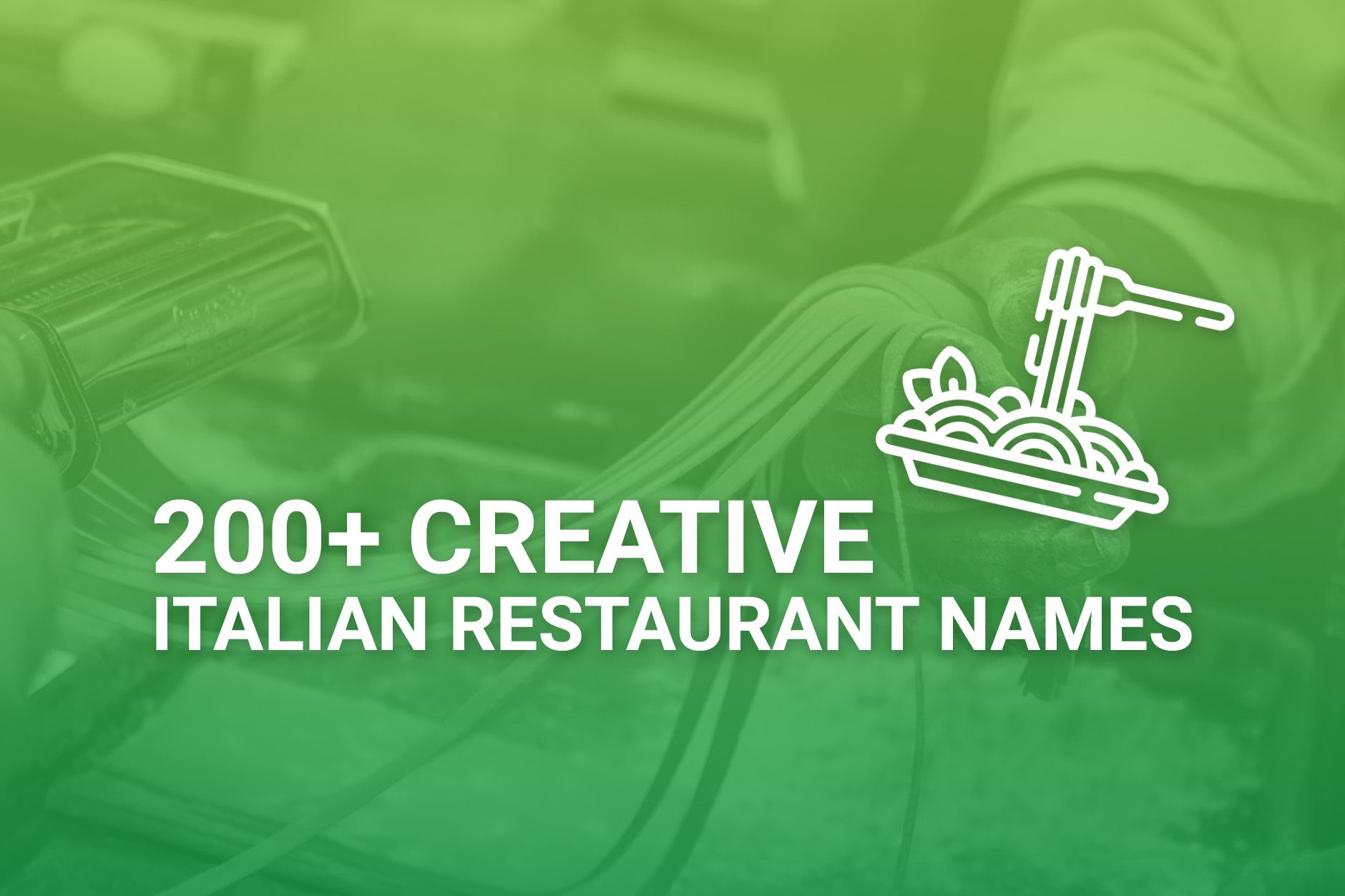What Makes a Great Italian Restaurant Name?
When it comes to choosing a name for an Italian restaurant, there are several key factors to consider. A great Italian restaurant name should reflect the culture and cuisine of Italy, while also being memorable and easy to pronounce. It’s a delicate balance between authenticity and marketability. A name that is too generic or clichéd may not stand out in a crowded market, while a name that is too obscure or difficult to pronounce may confuse potential customers.
So, what makes a great Italian restaurant name? For starters, it should be rooted in Italian culture and language. This could include using Italian words or phrases, referencing Italian landmarks or historical figures, or incorporating Italian culinary traditions. For example, a restaurant named “Bella Vita” (Beautiful Life) or “Tavola Italian Kitchen” effectively evokes the warmth and hospitality of Italian culture.
In addition to being culturally relevant, a great Italian restaurant name should also be memorable and easy to pronounce. Avoid using names that are too long or complicated, as they may be difficult for customers to remember or recommend to others. Instead, opt for a name that is short, catchy, and easy to spell. For example, a restaurant named “Pasta e Vino” (Pasta and Wine) is simple, yet effective, while a name like “Il Ristorante Italiano” (The Italian Restaurant) is more generic and may not stand out as much.
Ultimately, the key to choosing a great name for an Italian restaurant is to find a balance between authenticity, marketability, and memorability. By incorporating Italian culture and language, while also being mindful of the practical considerations of naming a business, you can create a name that will help your restaurant stand out in a crowded market and attract customers who are looking for an authentic Italian dining experience.
How to Choose an Authentic Italian Name
When it comes to choosing a name for an Italian restaurant, authenticity is key. A name that is genuinely rooted in Italian culture and language can help to establish your restaurant’s credibility and attract customers who are looking for an authentic Italian dining experience. But how do you choose a name that is truly Italian?
One approach is to use Italian words and phrases that reflect the cuisine and culture of Italy. For example, a restaurant named “Bella Vita” (Beautiful Life) or “La Dolce Vita” (The Sweet Life) effectively evokes the warmth and hospitality of Italian culture. You could also use Italian words that describe the type of cuisine you serve, such as “Pizzeria” or “Trattoria”.
Another approach is to reference Italian landmarks or historical figures. For example, a restaurant named “Trevi” after the famous fountain in Rome, or “Garibaldi” after the Italian general who played a key role in the country’s unification. This can help to create a sense of connection to Italy and its rich history.
However, it’s not just about using Italian words or references. A truly authentic Italian name should also reflect the nuances of the Italian language and culture. For example, a name that sounds Italian but is not actually used in Italy may not be effective. Similarly, a name that is too literal or translates poorly may not be memorable or catchy.
So, how can you ensure that your Italian restaurant name is authentic and effective? Here are a few tips:
- Research Italian language and culture to get a sense of the nuances and idioms that are used in Italy.
- Use Italian words and phrases that reflect the cuisine and culture of Italy.
- Reference Italian landmarks or historical figures to create a sense of connection to Italy.
- Test your name with native Italian speakers to ensure that it sounds natural and authentic.
By following these tips, you can choose a name for your Italian restaurant that is both authentic and effective. A name that reflects the culture and cuisine of Italy can help to establish your restaurant’s credibility and attract customers who are looking for an authentic Italian dining experience.
The Power of Alliteration and Wordplay
Alliteration and wordplay can be powerful tools in creating a memorable and catchy name for an Italian restaurant. By using repetitive sounds or clever turns of phrase, you can create a name that is both fun and memorable. For example, a restaurant named “Pasta la Vista” uses alliteration to create a catchy and memorable name, while also referencing the Italian dish of pasta.
Another example is “Bella Vita Bistro”, which uses alliteration to create a name that is both beautiful and memorable. The use of “Bella” (beautiful) and “Vita” (life) creates a sense of warmth and hospitality, while the alliteration makes the name more memorable.
Wordplay can also be used to create a clever and memorable name. For example, a restaurant named “The Saucy Italian” uses wordplay to create a name that is both clever and memorable. The use of “Saucy” references the Italian love of sauces, while also creating a sense of fun and playfulness.
When using alliteration and wordplay, it’s essential to ensure that the name is still easy to pronounce and remember. A name that is too clever or complicated may not be effective. Additionally, make sure that the name is not too similar to existing trademarks or brand names.
Here are some tips for using alliteration and wordplay in your Italian restaurant name:
- Use repetitive sounds to create a catchy and memorable name.
- Use clever turns of phrase to create a sense of fun and playfulness.
- Ensure that the name is still easy to pronounce and remember.
- Research existing trademarks and brand names to ensure that your name is unique.
By using alliteration and wordplay, you can create a name for your Italian restaurant that is both memorable and catchy. Just remember to keep it simple and easy to pronounce, and to ensure that it’s not too similar to existing trademarks or brand names.
https://www.youtube.com/watch?v=o-2Gc8pWoPk
Regional Italian Inspiration
Italy is a country with a rich regional diversity, each with its own unique cultural and culinary characteristics. When choosing a name for your Italian restaurant, you can draw inspiration from these different regions to create a name that reflects the authentic flavors and traditions of Italy.
For example, if you’re opening a restaurant that specializes in Tuscan cuisine, you might consider a name like “Toscana” or “La Bella Toscana” (The Beautiful Tuscany). These names evoke the rolling hills, charming villages, and rich culinary heritage of Tuscany, and will immediately convey to customers the type of cuisine they can expect to find.
Similarly, if you’re opening a restaurant that specializes in seafood from the Amalfi Coast, you might consider a name like “Costa d’Amalfi” or “La Marina” (The Marina). These names capture the essence of the Amalfi Coast’s stunning coastline, crystal-clear waters, and fresh seafood, and will transport customers to the sun-kissed Mediterranean.
Other regions of Italy that might inspire your restaurant’s name include:
- Campania, known for its rich tomato sauces and fresh mozzarella cheese
- Emilia-Romagna, famous for its prosciutto di Parma and Parmigiano-Reggiano cheese
- Veneto, with its rich tradition of seafood and risotto
- Sicily, with its unique blend of Italian, Greek, and Arab influences
When drawing inspiration from Italy’s regions, be sure to research the local culture, cuisine, and traditions to ensure that your name is authentic and respectful. You might also consider incorporating local ingredients, dishes, or cooking techniques into your menu to further reinforce the regional theme.
By tapping into the rich regional diversity of Italy, you can create a name for your Italian restaurant that is both unique and authentic, and that will transport customers to the heart of Italy.
Creating a Name that Reflects Your Menu and Atmosphere
When choosing a name for your Italian restaurant, it’s essential to consider the type of cuisine and atmosphere you want to create. A name that accurately reflects your menu and atmosphere can help to attract the right customers and set the tone for their dining experience.
For example, if you’re opening a restaurant that specializes in traditional Italian cuisine, you might consider a name like “Bella Vita” (Beautiful Life) or “La Dolce Vita” (The Sweet Life). These names evoke the warmth and hospitality of Italian culture, and suggest a cozy and inviting atmosphere.
On the other hand, if you’re opening a restaurant that serves modern Italian cuisine with a focus on fresh, locally-sourced ingredients, you might consider a name like “Fresca” (Fresh) or “Vino e Cucina” (Wine and Kitchen). These names convey a sense of freshness and simplicity, and suggest a more modern and upscale atmosphere.
It’s also important to consider the tone and personality of your restaurant when choosing a name. For example, if you’re opening a family-friendly restaurant with a casual atmosphere, you might consider a name like “Mama’s Kitchen” or “Papa’s Pizzeria”. These names are warm and inviting, and suggest a welcoming and informal atmosphere.
Here are some tips for creating a name that reflects your menu and atmosphere:
- Consider the type of cuisine you serve and the atmosphere you want to create.
- Use words and phrases that evoke the warmth and hospitality of Italian culture.
- Think about the tone and personality of your restaurant and choose a name that reflects it.
- Use simple and easy-to-pronounce words to ensure that your name is memorable and easy to spell.
By choosing a name that accurately reflects your menu and atmosphere, you can create a strong brand identity and attract the right customers to your Italian restaurant.
Avoiding Clichés and Overused Names
When it comes to choosing a name for your Italian restaurant, it’s essential to avoid clichés and overused names that can make your restaurant seem unoriginal and lacking in creativity. Names like “Bella Italia” or “That’s Amore” may seem like a good idea at first, but they’ve been used countless times before and can make your restaurant blend in with the crowd.
Instead, try to come up with a name that is unique and reflects the personality and style of your restaurant. For example, if you’re opening a modern Italian restaurant with a focus on fresh, locally-sourced ingredients, you might consider a name like “Fresca” or “Vino e Cucina”. These names are simple, yet effective, and convey a sense of freshness and simplicity.
Another approach is to use a name that references a specific aspect of Italian culture or cuisine, but in a way that is unique and creative. For example, you might consider a name like “Pasta e Passione” (Pasta and Passion) or “La Dolce Vita” (The Sweet Life). These names reference the Italian love of pasta and the sweet life, but in a way that is fresh and original.
Here are some tips for avoiding clichés and overused names:
- Avoid using names that are too generic or common.
- Try to come up with a name that is unique and reflects the personality and style of your restaurant.
- Use a name that references a specific aspect of Italian culture or cuisine, but in a way that is unique and creative.
- Steer clear of names that are too long or complicated.
By avoiding clichés and overused names, you can create a name for your Italian restaurant that is unique, memorable, and effective.
Brainstorming and Refining Your Name
Once you have a clear idea of what you want your Italian restaurant name to convey, it’s time to start brainstorming and refining your options. Here are some tips to help you generate a list of potential names and narrow down your choices:
Start by making a list of words and phrases that reflect the Italian culture and cuisine, as well as the atmosphere and menu of your restaurant. Consider using a mind map or brainstorming software to help you generate ideas.
Next, ask friends, family, and potential customers for their input and feedback. This can help you identify any potential issues with your name and get a sense of how it will be received by your target audience.
Refine your list of potential names by considering factors such as:
- Memorability: Is the name easy to remember and pronounce?
- Uniqueness: Does the name stand out from other Italian restaurants in your area?
- Relevance: Does the name accurately reflect the type of cuisine and atmosphere of your restaurant?
- Brandability: Is the name easy to brand and market?
Once you have narrowed down your list of potential names, it’s time to test them out. Try saying the name out loud, and ask others to do the same. This can help you identify any potential issues with the name and get a sense of how it will be received by your target audience.
Finally, consider seeking the advice of a professional, such as a branding expert or a marketing consultant. They can help you refine your name and ensure that it is consistent with your brand identity.
By following these tips, you can generate a list of potential names for your Italian restaurant and refine them until you find the perfect one.
Finalizing Your Restaurant’s Name
Once you have chosen a name for your Italian restaurant, it’s time to finalize it and make it official. Here are some steps to take to ensure that your name is properly trademarked, branded, and marketed:
First, conduct a trademark search to ensure that your name is not already in use by another business. You can use online resources such as the United States Patent and Trademark Office (USPTO) database to search for existing trademarks.
Next, register your name as a trademark with the USPTO. This will provide you with exclusive rights to use the name and prevent others from using it.
After registering your name, it’s time to start building your brand identity. This includes creating a logo, website, and social media accounts that reflect your restaurant’s name and image.
Finally, develop a marketing strategy that showcases your restaurant’s name and brand identity. This can include advertising, public relations, and social media marketing.
By following these steps, you can finalize your restaurant’s name and establish a strong brand identity that will help you attract customers and build a loyal following.
Some additional considerations when finalizing your restaurant’s name include:
- Ensuring that your name is consistent across all platforms, including your website, social media, and marketing materials.
- Creating a unique and memorable logo that reflects your restaurant’s name and brand identity.
- Developing a brand voice and tone that is consistent with your restaurant’s name and image.
By taking the time to properly finalize your restaurant’s name, you can establish a strong brand identity that will help you succeed in the competitive restaurant industry.







